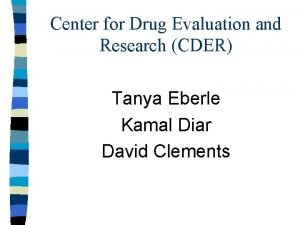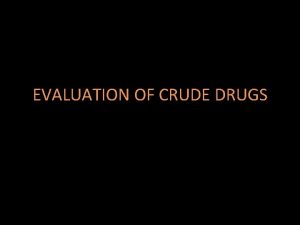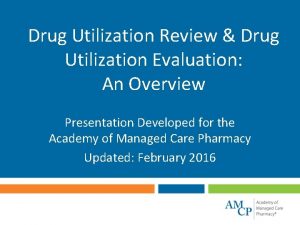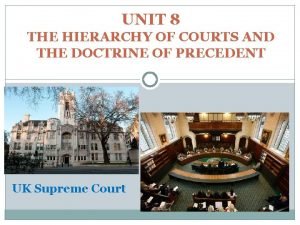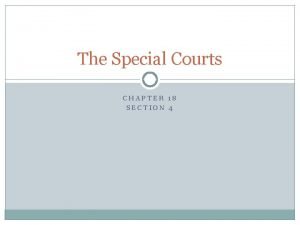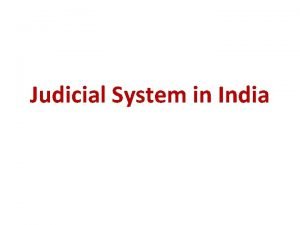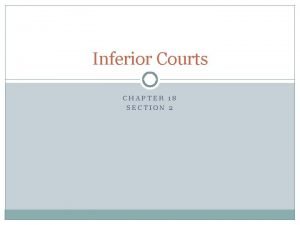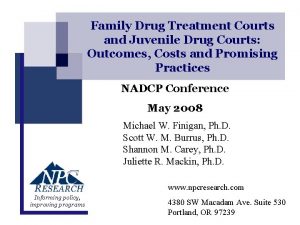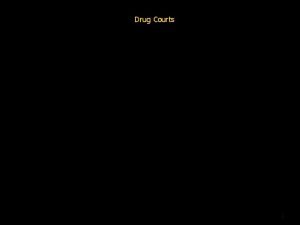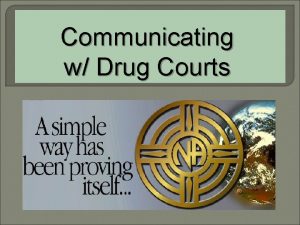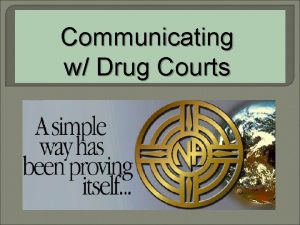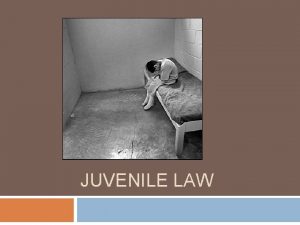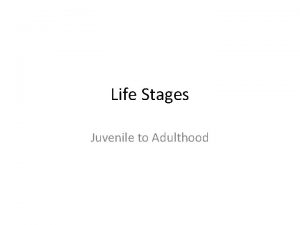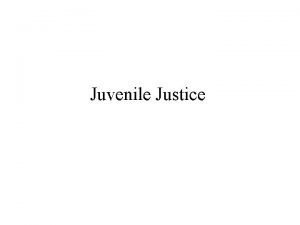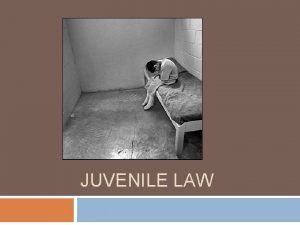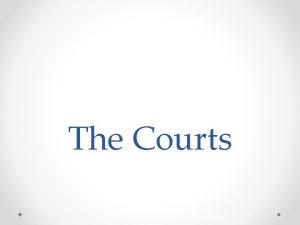National Cross Site Evaluation of Juvenile Drug Courts













- Slides: 13

National Cross Site Evaluation of Juvenile Drug Courts and Reclaiming Futures Erika Ostlie, M. A. Carnevale Associates, LLC April 10, 2012

Overview • Multi-Site, four-year evaluation of the Juvenile Drug Court and Reclaiming Futures Initiative • Will use both quantitative and qualitative methods to identify the factors, elements, and services that perform best with respect to outcomes and cost effectiveness • Six sites are currently included: Denver, CO; Ventura, CA; Cherokee Nation, Tahlequah, OK; Snohomish County, WA; Travis County, TX; Hocking County, OH

Evaluation Team • Southwest Institute for Research on Women (SIROW), University of Arizona • Carnevale Associates, LLC • Chestnut Health Systems

Why Should Juvenile Drug Courts and Reclaiming Futures be Integrated? • Maximizes treatment opportunities for qualified youth involved with the juvenile justice system • Permits youth involved in the juvenile justice system to be more effectively screened and assessed for substance abuse • More appropriate matching of youth with available treatment services • Treatment services are delivered via a coalition of providers working under the guidance of a local court

What will the Evaluation Show? • How implementation of the JDC and RF models actually occur • If 16 JDC elements and 6 RF principles are reflected systematically (ex. Client profiles, assessments, treatment referrals) • If youth in need are being assessed appropriately • If youth in need are being provided the services they need • If JDC/RF programs and their comparison groups impact long-term outcomes such as substance use and criminality

Objective 1: Assess the operations of Juvenile Drug Court/Reclaiming Futures models using established indices for performance, efficiencies and cost effectiveness • Evaluation of Drug Court/Change Teams • Focus on Service Data • Cost Effectiveness Study

Objective 2: Improve the empirical knowledge base about Juvenile Drug Courts and Reclaiming Futures • Data will be divided into three groups: ▫ Youth enrolled who complete JDC/RF ▫ Youth enrolled who do not complete JDC/RF ▫ Youth enrolled in the juvenile justice system who meet JDC/RF eligibility criteria, but are not enrolled in JDC/RF • For JDC/RF clients Service, GAIN, and GPRA data will be used for analysis • For non-JDC/RF clients, screening information provided by the sites will be used

Objective 3: Analyze the efficacy of combined efforts of the Juvenile Drug Court and Reclaiming Futures Models • Examine how each site integrated the two ▫ Look at each site’s strategic plan then conduct followup site visits ▫ Develop logic models based on results ▫ Define best practices • The evaluation will also review: ▫ ▫ Client recruitment/retention System-level interventions support matching System-level approaches and training/resources Changes in services related to participant and program performance

Objective 4: Conduct case studies using administrative, collaborative, and quality indices and the sixteen key elements of Juvenile Drug Courts • Will determine if individual norms, attitudes, and values lead to patterns of norms, attitudes and values that cut across the whole system • Will conduct four individuals case studies per site and two yearly system/organizational case studies

Objective 5: Evaluate the potential for replication of these models • The evaluation will permit a profile to be developed that shows who/what benefits most in the following areas: ▫ How the JDC/RF model operates ▫ The system/organizational culture that best supports the models ▫ The JDC/RF effect on system and client outcomes ▫ The efficacy of combining JDC/RF compared to other RF and JDC projects ▫ The cost effectiveness in relation to a comparison group

How is this Evaluation Unique? • Uses a mixed methodology approach ▫ Qualitative and quantitative methods ▫ Case studies, meta-analysis, quasi-experimental studies, and cost-benefit analyses • Evaluates JDC/RF at both the system and individual levels • Contains process and outcome evaluations

This Study will also Address a Huge Gap in the Literature • There are few published studies that have examined the efficacy of the drug court approach for juvenile populations • This study will examine the necessary elements for successful collaboration and coordination of services • The evaluation will provide insight on how JDCs can be improved in terms of system-level components, training, implementation, fidelity, and cost effectiveness

QUESTIONS?
 Methods of adulteration of crude drugs
Methods of adulteration of crude drugs Hot site cold site warm site disaster recovery
Hot site cold site warm site disaster recovery Center for drug evaluation and research
Center for drug evaluation and research Biological evaluation of crude drugs
Biological evaluation of crude drugs Drug utilization evaluation template
Drug utilization evaluation template National institute on drug abuse
National institute on drug abuse National institute for food and drug surveillance
National institute for food and drug surveillance Court hierarchy in uk
Court hierarchy in uk Hierarchy of the judicial system
Hierarchy of the judicial system Hierarchy of uk courts
Hierarchy of uk courts Chapter 18 section 4 the special courts worksheet answers
Chapter 18 section 4 the special courts worksheet answers Tennis courts wolverhampton
Tennis courts wolverhampton Judiciary system in india
Judiciary system in india Chapter 18 section 2 the inferior courts answer key
Chapter 18 section 2 the inferior courts answer key


